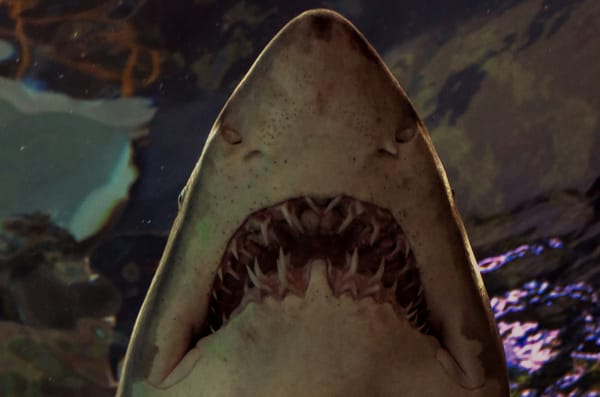The Frog Pond #23: Let Mushrooms Take the Wheel and ✨ BOOK NEWS ✨
In this month's Frog Pond: Mushrooms drive tiny robots and a fancy new book title is dredged up from the depths.
Skip to the writing update to find out the new title of my debut novel!! Otherwise please enjoy the mycelium motor madness!
Mycelial mechanics
I was overwhelmed with articles last month promising apocalyptic destruction thanks to mushrooms that could drive cars. After some digging, I found a much more interesting research paper on the subject that might help save the planet, not destroy it.
Cultures of king oyster mushrooms took control of two small robots' movements thanks to a joint research project at Cornell University and the University of Florence1. One "starfish" robot can twitch and roll its five limbs to move across flat surfaces while the other stands on four wheels. Both could be "controlled" by mushrooms through the electrochemical pulses of their mycelial network1.
While flora and fauna have been used to create biorobots, fungi are a new realm to explore. In many ways they make sense: Fungi can survive in many environments that other organisms can't, are easily cultivated, and are natural "explorers" since the threads of mycelia will stretch and weave through soil to find resources1.
Where do "roboshrooms" want to go?
Harnessing the movements of mushrooms doesn't seem particularly useful at first, given that while mushrooms have surprisingly neural-like communication2, they don't have the processing or sentience to understand the concept of driving. But by applying a control model using the rhythm of the voltage spikes in mycelial electric pulses, researchers can alter the robot's trajectories. By stimulating the mycelia with UV light, they ware able to direct the robot through the mushroom's movements3.
So no, the mushrooms are not going to head anywhere in particular on their own, but this advancement in biorobotics may lead to harnessing mycelia sensory abilities to create a living system1. While the fungus can't visualize anything, the robot can interpret signals and visualize for it1.
The control system was inspired by neural central pattern generators, once again linking the structures of mycelia and brains3.
How could the roboshrooms help?
The researchers believe that some of the applications of these mushmechs (I'm willing to grant this name to any researcher who asks) could include tasks such as delivering precise amounts of nutrients or pesticides to a soil environment and automatically tailoring responses to rising levels of pollutants1.
I think there's something lovely about the idea of using mushrooms, who are already pulling higher than their weight class in terms of keeping our environments healthy, to help sustainability efforts.
Overall the concept of biorobots can seem like a cyberpunk dystopia ready to take over, but as with most scientific discoveries the reality is much smaller scope and simpler than a tweet or clickbait article would suggest. For now, the only nefarious use of roboshrooms would be the fault of the human operator, not the threads of fungus reacting and reaching within the robot3.
A word from a passing frog
I'm so sorry for missing a month! The new day job has been a big (but good!) adjustment. And now we are so back.
Publishing/Writing
Dredged up from the deep, a new and improved title for my debut novel slated for 2025 with Sourcebooks:
"A FATE WORSE THAN DROWNING"
(I love it so much!! 😭💙)
I'm so thankful to have the help of my fantastic editor Jenna at Sourcebooks to find a title that fits every facet of this haunting, yearning, dread-inducing book. I think it captures the heart of the book and I can't wait to see it, along with my name, on the cover!
It's so funny to think of how this book was first known simply as "Lighthouse book" to my friends, then by the originally announced title, and now by something that feels more like what will be a real book than anything before.
A FATE WORSE THAN DROWNING is my love letter to complex sisterhood, feminine rage, toxic sacrifice, the ocean, & queer characters in historical fiction.
The book feature two runaway sisters turned lighthouse keepers, a deal with the Devil to drown sailors in return for safety (and dark power), and a shipwrecked survivor that breaks one sister's deal and steals the other's heart. Its set in 1861 on Devils Island, Nova Scotia, just outside the harbour of my hometown. Devils Island has a rich history of folktales and mysteries that inspired my story of these two young women's wayward search for freedom and love.
Reading
My reading, predictably, went down after I got this year's goal haha. I've made progress in a bunch of different books, including: Authority by Jeff Vandermeer (doing a re-read of the series with the 4th book coming out!), Godkillers by Hannah Kaner, Blood at the Root by LaDarrion Williams, and Harrow the Ninth by Tamsyn Muir.
Enjoying the Frog Pond? Please consider sharing with a friend!
Footnotes
1: https://www.sciencealert.com/engineers-gave-a-mushroom-a-robot-body-and-let-it-run-wild
2: https://www.sciencealert.com/fungi-communicate-with-patterns-that-look-uncannily-like-our-own-speech





